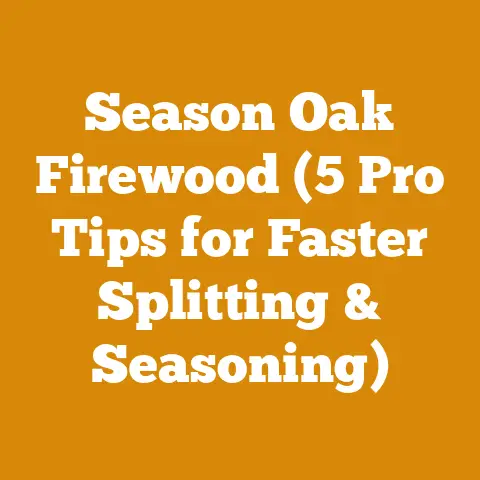Rear Vented Wood Stoves (5 Pro Tips for Efficient Heat)
As the crisp air of late autumn begins to bite, and the first snowflakes threaten to dust the landscape, my thoughts invariably turn to the comforting warmth of a wood stove. There’s something deeply satisfying about the crackling fire, the radiating heat, and the knowledge that you’re prepared for whatever winter throws your way. Over the years, I’ve come to rely heavily on my rear-vented wood stove, but like any tool, it performs best when understood and properly maintained.
Unlike top-vented stoves, they often require a different approach to installation and operation. Through my years of experience heating my home with wood, and helping others do the same, I’ve learned a few tricks to maximize their efficiency and minimize fuel consumption. Let’s dive into 5 pro tips that will help you get the most out of your rear-vented wood stove.
1. Understanding Rear Venting and its Implications
Before we get into the tips, let’s understand why rear-vented stoves exist and how they work. Rear venting allows for a closer placement to the wall, saving valuable floor space, especially in smaller homes or cabins. However, this design also means the flue pipe exits horizontally before turning upwards, which can impact draft.
Think of it like this: hot air rises, and a straight, vertical flue offers the least resistance. A horizontal section adds resistance, making it harder for the stove to “breathe” and exhaust smoke properly. This is why a strong draft is crucial for a rear-vented stove.
- Key Takeaway: The horizontal run of the flue pipe is the Achilles’ heel of a rear-vented system. Minimize its length and ensure a strong, consistent draft.
2. Optimizing Flue Pipe Installation for Draft
The flue pipe is the lifeline of your wood stove, and its installation directly impacts the stove’s efficiency and safety. For rear-vented stoves, this is even more critical.
-
Minimize Horizontal Run: As mentioned earlier, keep the horizontal section as short as possible. Ideally, it should be less than 3 feet. Longer runs significantly reduce draft and increase the risk of creosote buildup. I once made the mistake of having a 5-foot horizontal run and the stove just wouldn’t draw properly, leading to smoky startups and inefficient burning. A costly and frustrating mistake!
-
Ensure Proper Slope: The horizontal section should slope upwards slightly (about ¼ inch per foot) towards the chimney. This helps gravity assist the flow of smoke and prevents creosote from pooling in the pipe.
-
Maintain Adequate Chimney Height: The chimney must extend at least 3 feet above the highest point where it exits the roof and at least 2 feet higher than any part of the building within 10 feet. This ensures sufficient draft. A taller chimney creates a stronger “pull” and helps overcome the resistance of the horizontal flue section.
-
Use Insulated Flue Pipe (Highly Recommended): Insulated flue pipe maintains higher flue temperatures, which promotes a stronger draft and reduces creosote formation. While more expensive upfront, the long-term benefits outweigh the cost. I switched to insulated pipe a few years ago and noticed a significant improvement in my stove’s performance and reduced creosote buildup.
Cost Considerations:
- Single-wall flue pipe: \$20-\$40 per foot
- Double-wall flue pipe: \$40-\$80 per foot
- Insulated flue pipe: \$80-\$150 per foot
Data Point: According to the Chimney Safety Institute of America (CSIA), poorly installed or maintained chimneys are a leading cause of residential fires. Investing in proper flue pipe and installation is an investment in safety.
3. Mastering the Art of the Top-Down Fire
Traditional fire starting involves placing kindling on top of newspaper, then larger pieces of wood on top of the kindling. While this method works, it’s not the most efficient, especially for rear-vented stoves that are more sensitive to draft.
Enter the top-down fire. This method involves placing the largest pieces of wood at the bottom, followed by progressively smaller pieces, with kindling and fire starters on top.
-
Why it works: The top-down fire creates a cleaner, hotter burn from the start. The flames burn downwards, preheating the wood below and releasing volatile gases more slowly and efficiently. This reduces smoke and creosote production, which is crucial for rear-vented stoves.
-
My Experience: When I first switched to the top-down method, I was amazed at how quickly my stove heated up and how much cleaner the burn was. No more struggling with smoky startups!
-
How to Build a Top-Down Fire:
- Place 3-4 large pieces of wood at the bottom of the firebox.
- Add a layer of smaller pieces of wood perpendicular to the bottom layer.
- Place kindling on top of the smaller pieces.
- Place a fire starter (e.g., a wax-based cube) on top of the kindling.
- Light the fire starter.
4. Fueling Efficiency: Wood Selection and Preparation
The type and quality of wood you burn significantly impact your stove’s efficiency and the amount of heat it produces. Burning wet or unseasoned wood is a recipe for inefficiency, excessive smoke, and creosote buildup.
-
Seasoned Wood is King: Seasoned wood has a moisture content of 20% or less. This means the wood has been allowed to dry for at least 6 months, preferably longer. Seasoned wood burns hotter, cleaner, and more efficiently.
-
How to Tell if Wood is Seasoned:
- Weight: Seasoned wood is significantly lighter than green wood.
- Cracks: Seasoned wood often has cracks in the end grain.
- Sound: When struck together, seasoned wood will make a hollow sound, while green wood will sound dull.
- Moisture Meter: A moisture meter is the most accurate way to measure the moisture content of wood.
-
Wood Species Matters: Different wood species have different heat values. Hardwoods like oak, maple, and beech produce more heat per cord than softwoods like pine and fir.
- BTU Content (Approximate per Cord):
- Oak: 24-30 million BTU
- Maple: 20-25 million BTU
- Beech: 22-28 million BTU
- Pine: 12-18 million BTU
- BTU Content (Approximate per Cord):
-
Splitting Wood for Efficiency: Splitting wood into smaller pieces increases the surface area exposed to the flames, allowing it to dry faster and burn more efficiently.
Cost Considerations:
- Seasoned Hardwood (Oak, Maple): \$200-\$400 per cord
- Seasoned Softwood (Pine, Fir): \$150-\$300 per cord
- Unseasoned Wood: Significantly cheaper, but requires seasoning time and reduces efficiency.
Data Point: According to the U.S. Department of Energy, burning seasoned wood can increase heating efficiency by as much as 50% compared to burning green wood.
My Story: I once tried to save money by burning unseasoned pine. It was a disaster! The stove smoked constantly, produced very little heat, and the chimney was coated in creosote within a few weeks. I learned my lesson the hard way: seasoned hardwood is worth the investment.
Estimating Drying Time:
Drying time depends on factors like wood species, climate, and how the wood is stacked. Generally, hardwoods take longer to season than softwoods.
- Formula: Drying Time (Months) = K * (Moisture Content – 20%)
- Where K is a constant that varies depending on the wood species and climate (typically between 0.5 and 1.5).
5. Regular Maintenance: Keeping Your Stove Running Smoothly
Regular maintenance is essential for maximizing the efficiency and lifespan of your wood stove. This includes cleaning the flue pipe, inspecting the stove for damage, and replacing worn parts.
-
Flue Pipe Cleaning: Creosote is a flammable byproduct of wood combustion that can build up in the flue pipe and chimney. Regular cleaning is essential to prevent chimney fires. The frequency of cleaning depends on the type of wood you burn and how often you use the stove.
- Recommendation: Inspect the flue pipe every month and clean it at least once a year, or more often if necessary. I clean mine twice a year – once in the fall before heating season and once in the spring after heating season.
-
Stove Inspection: Regularly inspect the stove for cracks, leaks, and worn parts. Pay particular attention to the door gasket, which seals the firebox and prevents air leaks.
-
Door Gasket Replacement: A worn door gasket allows air to leak into the firebox, reducing efficiency and making the stove harder to control. Replace the gasket as needed. I usually replace mine every other year.
-
Baffle Inspection and Cleaning: The baffle is a component inside the firebox that helps to direct the flow of gases and improve combustion. It can become coated with soot and creosote over time, reducing its effectiveness. Clean the baffle regularly.
Cost Considerations:
- Chimney Sweep: \$150-\$300 per cleaning
- Chimney Cleaning Kit (DIY): \$50-\$100
- Door Gasket: \$10-\$20
- Baffle Replacement (if needed): \$50-\$150
Data Point: According to the National Fire Protection Association (NFPA), chimney fires are a significant cause of residential fires. Regular maintenance can prevent these fires and save lives.
My Routine: Every spring, I do a thorough inspection and cleaning of my stove. I remove the baffle, clean the flue pipe, inspect the door gasket, and touch up any rust spots with high-temperature paint. It takes a few hours, but it’s well worth the effort.
Budgeting for Firewood and Wood Stove Operation
Now that we’ve covered the pro tips, let’s talk about budgeting for firewood and wood stove operation. Heating with wood can be a cost-effective alternative to other heating methods, but it’s important to understand the costs involved.
Cost Components:
-
Firewood Purchase or Harvesting:
- Purchase: As mentioned earlier, the cost of firewood varies depending on the species, seasoning, and location. Expect to pay between \$150 and \$400 per cord.
- Harvesting: If you harvest your own wood, you’ll need to factor in the cost of tools (chainsaw, axe, splitter), fuel, and permits (if required).
-
Tool Maintenance: Chainsaws and wood splitters require regular maintenance, including sharpening, oiling, and parts replacement.
- Chainsaw Sharpening: \$10-\$20 per sharpening
- Chainsaw Chain Replacement: \$20-\$40
- Wood Splitter Rental: \$50-\$100 per day
-
Labor (If Applicable): If you hire someone to cut, split, and stack your wood, you’ll need to factor in labor costs.
- Labor Rate: \$20-\$40 per hour
-
Flue Pipe Cleaning: As mentioned earlier, professional chimney sweeping costs between \$150 and \$300 per cleaning.
-
Permits (If Required): Some areas require permits for wood harvesting or burning. Check with your local authorities.
Sample Budget:
Let’s say you plan to burn 4 cords of seasoned hardwood per year and you hire a chimney sweep once a year.
- Firewood: 4 cords x \$300/cord = \$1200
- Chimney Sweep: \$200
- Tool Maintenance: \$50 (estimated)
- Total Annual Cost: \$1450
This translates to approximately \$3.97 per day for heating, which may be significantly lower than the cost of heating with oil, gas, or electricity.
Cost Optimization Tips:
- Buy Firewood in Bulk: Buying firewood in larger quantities often results in a lower price per cord.
- Harvest Your Own Wood (If Possible): Harvesting your own wood can save you money, but it requires time, effort, and the right tools.
- Season Your Own Wood: Buying unseasoned wood and seasoning it yourself can save you money, but it requires patience.
- Maintain Your Tools: Regular maintenance will extend the lifespan of your tools and prevent costly repairs.
- Shop Around for Chimney Sweeps: Get quotes from multiple chimney sweeps to ensure you’re getting the best price.
- Consider a Wood Stove Insert: If you have an existing fireplace, a wood stove insert can be a more efficient heating option.
Understanding Timber Prices and Equipment Costs
To further refine your budgeting, let’s delve into the specifics of timber prices and equipment costs.
Timber Prices:
Timber prices fluctuate based on factors like species, grade, location, and market demand.
- Global Timber Prices: Global timber prices are influenced by factors like deforestation, climate change, and economic growth. Organizations like the Food and Agriculture Organization of the United Nations (FAO) track global timber prices.
- Regional Timber Prices: Regional timber prices vary depending on local market conditions. Contact local sawmills or forestry agencies for current pricing information.
Data Point: According to the FAO, global timber prices have been increasing in recent years due to increasing demand and decreasing supply.
Equipment Costs:
- Chainsaws: Chainsaw prices range from \$100 for a basic homeowner model to \$1000 or more for a professional-grade model.
- Wood Splitters: Wood splitter prices range from \$500 for a manual splitter to \$5000 or more for a hydraulic splitter.
- Axes and Mauls: Axes and mauls are essential tools for splitting wood. Prices range from \$50 to \$200.
- Safety Gear: Safety gear, including a helmet, eye protection, hearing protection, and gloves, is essential for safe wood processing.
Cost Comparison Table:
| Tool | Price Range | Pros | Cons |
|---|---|---|---|
| Chainsaw | \$100-\$1000+ | Versatile, can be used for felling trees, bucking logs, and limbing branches. | Requires maintenance, can be dangerous if not used properly. |
| Wood Splitter | \$500-\$5000+ | Makes splitting wood faster and easier, especially for large logs. | Can be expensive, requires storage space. |
| Axe/Maul | \$50-\$200 | Inexpensive, requires no fuel or electricity, good for splitting small to medium-sized logs. | Requires physical effort, can be time-consuming. |
| Safety Gear | \$50-\$200 | Essential for protecting yourself from injury. | None. |
Actionable Takeaways and Next Steps
Heating with a rear-vented wood stove can be a rewarding and cost-effective way to heat your home, but it requires knowledge, planning, and maintenance. By following the pro tips outlined in this article, you can maximize your stove’s efficiency, minimize fuel consumption, and stay warm all winter long.
Here are some actionable takeaways and next steps:
- Inspect your flue pipe and chimney: Ensure they are clean and in good condition.
- Season your firewood: Allow your firewood to dry for at least 6 months before burning it.
- Master the top-down fire: This method creates a cleaner, hotter burn.
- Maintain your stove: Regularly clean and inspect your stove for damage.
- Create a budget: Track your firewood and maintenance costs to ensure you’re staying within your budget.
Heating with wood is more than just a way to stay warm; it’s a connection to nature, a source of independence, and a skill passed down through generations. By understanding the nuances of rear-vented wood stoves and mastering the art of wood processing, you can enjoy the many benefits of this time-honored tradition. So, as the snow falls and the wind howls, stoke the fire, settle in, and enjoy the warmth and comfort of your wood-heated home.






